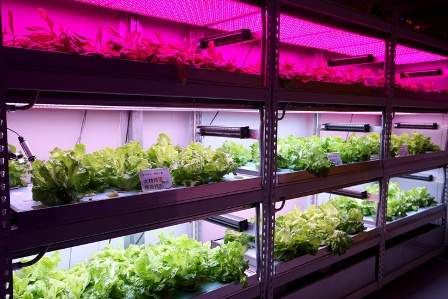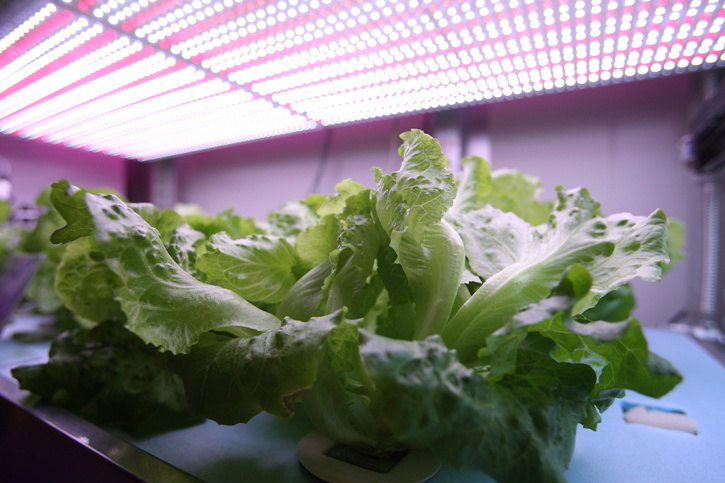Plant factories: the future of farming?
Plant factories: the future of farming?

Plant factories allow cultivation to go three-dimensional, significantly increasing crop yield per unit area. (Staff photos/Chen Mei-ling)
To most people, food from a factory means processed fare such as packaged or canned food. However, high-tech “plant factories” now allow fresh fruit and vegetables to be produced in an industrial manner, according to Fang Wei, a professor at National Taiwan University’s Department of Bio-Industrial Mechatronics Engineering.
This approach, Fang said, produces crops in closed environments in which all the important elements needed for plant growth—air, light, nutrients and water—are artificially controlled.
“A plant factory is a closed growing environment in which air conditioning and lighting sources such as fluorescent lamps and light-emitting diodes, or LEDs, are used to replace natural ventilation and sunlight,” he said. “Temperature and humidity are also carefully adjusted so that the effects of detrimental weather conditions can be eliminated.”
As a result, Fang said, any kind of produce can be cultivated in areas with harsh climates as long as there is a sufficient supply of water and electricity. “Put simply, a plant factory can produce crops of consistent quality and guarantee a steady year-round harvest, resulting in stable prices,” he said. These characteristics are quite similar to those of a factory in the industrial sector, he added.
According to Fang, such indoor farming also effectively keeps pests and germs at bay if sufficient sanitary controls are implemented. In other words, there is no need for pesticides.
“When soil is replaced with water or non-soil materials, such as disinfected peat or tissue fibers from minerals, the number of germs in the plants can be reduced to 0.1 percent of those found in their counterparts cultivated in the traditional way. This number is low enough for the produce to be safely eaten uncooked.”
Plant factories have many advantages over traditional farming and greenhouses, Fang said. “The most obvious one is that cultivation is allowed to go three-dimensional,” he pointed out. Instead of being planted in the ground, crops are grown in trays in multilayer cultivation shelves, with artificial lights installed above and nutrient solutions supplied directly to their roots.
In addition, he said, as plant factories are more highly controlled environments than greenhouses, resources that fuel plant growth can be utilized more efficiently. “For example, extra water in a typical greenhouse or field just overflows to drains or evaporates, but in a plant factory, condensed water is eventually captured in air conditioners and reused on plants,” he said. “Therefore, the amount of irrigation water required is only about 2 percent of that needed in open-field farming.”

varieties unsuited to tropical areas are good candidates for plant factory starters in Taiwan.
Despite all these advantages, in Taiwan this new way of farming is developing slowly and sporadically, on a small scale, due to higher initial equipment investment, Fang said. Other concerns include higher energy costs, inadequately developed cultivation technology, a limited range of crops and blander-tasting vegetables than those grown by more traditional methods.
NTU has established two plant factories on campus to improve farming technology and increase the number of crops that can be produced by plant factories. “As the nation is developing sources of renewable energy, it will also be possible to power these facilities with green energy, making them more environmentally friendly,” Fang said.
Aside from NTU, only a handful of firms, including LED manufacturers Everlight Electronics Co. Ltd. and Genesis Photonics Inc., have built plant factories in Taiwan, and these are designed only for testing their lighting products for export to plant factories overseas.
“The primary motivation for these enterprises is selling farming equipment rather than growing vegetables,” he said.
Fang admitted that high setup costs are the biggest drawback of the plant factory system, but the potential return could be well worth the investment. “The average cost of production per unit area is indeed higher in plant factories, but if you take into account the stackable cultivation trays and the facility’s immunity to unpredictable weather conditions, you’ll see the yield per unit area could be 30 to 40 times higher than that from greenhouses.”
Many of Taiwan’s neighboring countries, especially Japan, mainland China and South Korea, have spotted the huge potential business opportunities stemming from plant factories, Fang said, and their governments have stepped in to support the expansion of the new industry. In Japan, he noted, there are about 50 plant factories in operation and the government is injecting roughly US$179 million to lift the number to as many as 150 by 2012.
There is such strong state sponsorship because the development of plant factories helps produce fruits and vegetables that cannot otherwise be grown in the local climate, according to Fang. It also spurs growth in related sectors such as LEDs, semiconductors and clean room technology. However, the Taiwan government has not made any aggressive moves, he said, possibly because it has not foreseen the real need for the new farming system.
Yet according to Fang, although vegetable prices are already quite low in Taiwan, there is still room for plant factories to make significant contributions to the local agricultural sector.
“We still rely too much on imports of lettuce and other leafy greens used in salads,” he said. “Since the climate here is too warm to grow these vegetables, plant factories are a good option.” Taiwan also has a competitive edge in developing this technology with its low-cost supply of domestic LEDs and semiconductor products, he added.
Moreover, by producing all kinds of vegetables locally, plant factories would help reduce the carbon footprint associated with food transport. He urged the government and interested enterprises to take the opportunity and begin with crops of high economic value. “Lettuce, strawberries and herbs used in traditional Chinese medicine, such as salvia roots and Chinese caterpillar fungus, should be great candidates,” he said. (THN)
Write to Audrey Wang at audrey@mail.gio.gov.tw